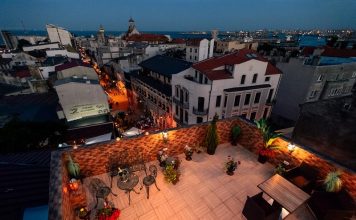Inspired Architectural Designers Worldwide
Source: Link
Seeing the Pantheon in person is like a dream come true for so many travelers. It is after all one of the most significant structures in the Rome and the whole world. If you’re visiting the city soon then this list will prepare you for the masterpiece of a structure you’re about to see. Pantheon for good reason is one of the top spots to visit during a trip to Rome. Here are 10 facts about it that will make you appreciate it more! Many builders all over the world have been inspired by the majesty of the Pantheon’s architecture. Thomas Jefferson was one of the designers who copied the design and constructed the replica at the Grounds of the University of Virginia in 1822. It originally housed a library, but the construction continued even after his death in 1826. And this is just the beginning of great architects and artists being inspired by this wonder. Click the next ARROW to see the next image!
Housed Tons Of Popular Dead Personalities
Source: Link
Since the Renaissance, the Pantheon served as a tomb for artists such as Annibale Carracci, Raphael, and famous composer Arcangelo Corelli. Along with them are Italian kings Umberto I and Vittorio Emanuele II, as well as Umberto’s wife Queen Margherita. Click the next ARROW to see the next image!
The Pantheon Served As A Church
Source: Link
The Pantheon was a gift to Pope Boniface IV from Emperor Phocas in 609 C.E. The Pope then consecrated the building as the Church of Santa Maria ad Martyres. The secret to its pristine condition was due to its continued use 2 millennia after its construction. Click the next ARROW to see the next image!
The Oculus Was Thought As A Sundial
Source: Link
Giulio Magli and Robert Hannah both believe that the oculus was designed to serve as a sundial. Even visitors can tell time just by the passing of the sun at the overhead shadow. Moreover, the beams shining via the opening illuminate the doorway into the rotunda. Click the next ARROW to see the next image!
A Huge Hole Serves As Natural Light Source For The Pantheon
Source: Link
The Pantheon has another remarkable feature, a wide opening at the ceiling which measures 27 feet. This was referred to as the oculus, which is the Latin term for eye. Inside the Pantheon, the oculus serves as the sole source of natural light. Click the next ARROW to see the next image!
Features The World’s Biggest Unreinforced Concrete Dome
Source: Link
The height and diameter of the dome measure 142 feet, in which the big interior is among the highlights of the Pantheon. However, the thickness of the dome diminishes as it goes higher, going from 21ft to 4ft on top. Click the next ARROW to see the next image!
It Served As A Temple
Source: Link
The word Pantheon was thought to be derived from the Greek term which refers to a temple intended for the gods. Pan means all, while Theon means gods. This might be because of the statues of different gods throughout the interior. However, scholars thought otherwise, as it might have been referred to the vaulted roof that resembles the heavens. Click the next ARROW to see the next image!
It Has A Very Strong Foundation
Source: Link
The secret to its strong foundation is the special type of concrete. It has withstood the test of time and natural calamities, but the Pantheon remained upright. The use of volcanic ash and limestone mixed with concrete enables the mixture to form crystals that should’ve prevented the increase of microscopic cracks. Click the next ARROW to see the next image!
It Was Rebuilt Between 118 To 125 C.E.
Source: Link
The initial destruction of the Pantheon has led to its reconstruction 40 years after as a temple for the gods. The mark of Agrippa, on the other hand, remained in front of the building. The inscription translates that this structure was built by Marcus Agrippa, the son of Lucius, the Consul for the 3rd time. Click the next ARROW to see the next image!
The Original Pantheon Was Destroyed
Source: Link
The first Pantheon was burned down around 80 C.E. It was first built by a Roman architect and statesman by the name of Marcus Vispanius Agrippa at around 27 B.C.E. This was built on his property in Campus Martius.
























